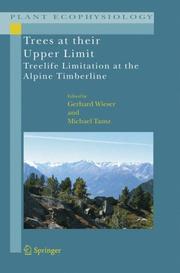| Listing 1 - 3 of 3 |
Sort by
|

ISBN: 1280901918 9786610901913 1402050747 1402050739 9048172756 Year: 2007 Publisher: Dordrecht : Springer,
Abstract | Keywords | Export | Availability | Bookmark
 Loading...
Loading...Choose an application
- Reference Manager
- EndNote
- RefWorks (Direct export to RefWorks)
Emerging from decades of intensive research into alpine timberlines, Trees at their Upper Limit presents a complete modern synthesis of current knowledge on the ecophysiology of tree growth and survival on high mountains in Europe. Including chapters on soil properties and the role or mycorrhiza, carbon assimilation and allocation, phytopathogens, and the impact of global change on photooxidative stress, the book builds on Tranquillini’s landmark 1979 publication, Physiological Ecology of the Alpine Timberline. By combining new techniques and insights with existing core knowledge the authors explore a range of current hypotheses on tree life limitation to promote a greater understanding of the underlying mechanisms determining the upper timberline. Amid growing realization that high elevation forests have a crucial role to play in protection against natural hazards, this book represents a timely contribution to the current literature on timberline research. Drawing together more than 25 years of work, this unique book sets a new standard on the ecophysiology of trees growing at the alpine timberline. Edited by field leaders Gerhard Wieser and Michael Tausz, the book will appeal to researchers and advanced students in the fields of botany, ecology and plant ecophysiology, as well as to a wider audience interested in understanding the responses of the timberline ecotone to climatic and demographic change.
Timberline --- Trees --- Mountain ecology. --- Ecophysiology --- Alpine ecology --- Alpine region ecology --- Alpine regions --- Mountains --- Upland ecology --- Dendrology --- Nursery stock --- Woody plants --- Arboriculture --- Forests and forestry --- Timber --- Alpine timberline --- Alpine treeline --- Latitudinal timberline --- Latitudinal treeline --- Timber-line --- Tree line --- Treeline --- Forest ecology --- Mountain ecology --- Vegetation boundaries --- Ecology --- Forests and forestry. --- Trees. --- Plant physiology. --- Plant Ecology. --- Forestry. --- Tree Biology. --- Plant Physiology. --- Botany --- Plants --- Forest land --- Forest lands --- Forest planting --- Forest production --- Forest sciences --- Forestation --- Forested lands --- Forestland --- Forestlands --- Forestry --- Forestry industry --- Forestry sciences --- Land, Forest --- Lands, Forest --- Silviculture --- Sylviculture --- Woodlands --- Woods (Forests) --- Agriculture --- Natural resources --- Afforestation --- Logging --- Tree crops --- Physiology --- Phytoecology --- Vegetation ecology --- Plant ecology. --- Floristic ecology
Book
ISBN: 3110597748 3110690314 3110593580 3110595273 Year: 2020 Publisher: Berlin/Boston De Gruyter
Abstract | Keywords | Export | Availability | Bookmark
 Loading...
Loading...Choose an application
- Reference Manager
- EndNote
- RefWorks (Direct export to RefWorks)
In all religions, in the medieval West as in the East, ideas about the past, the present and the future were shaped by expectations related to the End. The volumes Cultures of Eschatology explore the many ways apocalyptic thought and visions of the end intersected with the development of pre-modern religio-political communities, with social changes and with the emergence of new intellectual and literary traditions. The two volumes present a wide variety of case studies from the early Christian communities of Antiquity, through the times of the Islamic invasion and the Crusades and up to modern receptions, from the Latin West to the Byzantine Empire, from South Yemen to the Hidden Lands of Tibetan Buddhism. Examining apocalypticism, messianism and eschatology in medieval Christian, Islamic, Hindu and Buddhist communities, the contributions paint a multi-faceted picture of End-Time scenarios and provide their readers with a broad array of source material from different historical contexts. The first volume, Empires and Scriptural Authorities, examines the formation of literary and visual apocalyptic traditions, and the role they played as vehicles for defining a community's religious and political enemies. The second volume, Time, Death and Afterlife, focuses on key topics of eschatology: death, judgment, afterlife and the perception of time and its end. It also analyses modern readings and interpretations of eschatological concepts.
HISTORY / General. --- Medieval history --- apocalypticism --- messianism --- eschatology --- End-Time scenarios
Book
ISBN: 3839463963 3837663965 Year: 2023 Publisher: Bielefeld : transcript,
Abstract | Keywords | Export | Availability | Bookmark
 Loading...
Loading...Choose an application
- Reference Manager
- EndNote
- RefWorks (Direct export to RefWorks)
Leaking water infrastructures, heritage tourism, investments in artworks, failing electronics: durability lies at the heart of a wide range of seemingly unrelated phenomena. Durable things are both a hugely significant source of wealth and a constant source of struggle. The contributors argue that a deeper engagement with durability is essential for reaching an understanding of how economies work; and for envisaging alternative economies built on principles of environmental stewardship and social justice. Placing durability at the core of economic analysis, this volume explores the work and tensions involved in the production and valuation of durability to outline a new agenda for more sustainable economies.
SOCIAL SCIENCE / Sociology / General. --- Circular Economy. --- Durable Goods. --- Economic Sociology. --- Economy. --- Obsolescence. --- Repair. --- Sociology of Technology. --- Sociology of Work and Industry. --- Sociology. --- Sustainability. --- Technology. --- Work.
| Listing 1 - 3 of 3 |
Sort by
|

 Search
Search Feedback
Feedback About UniCat
About UniCat  Help
Help News
News